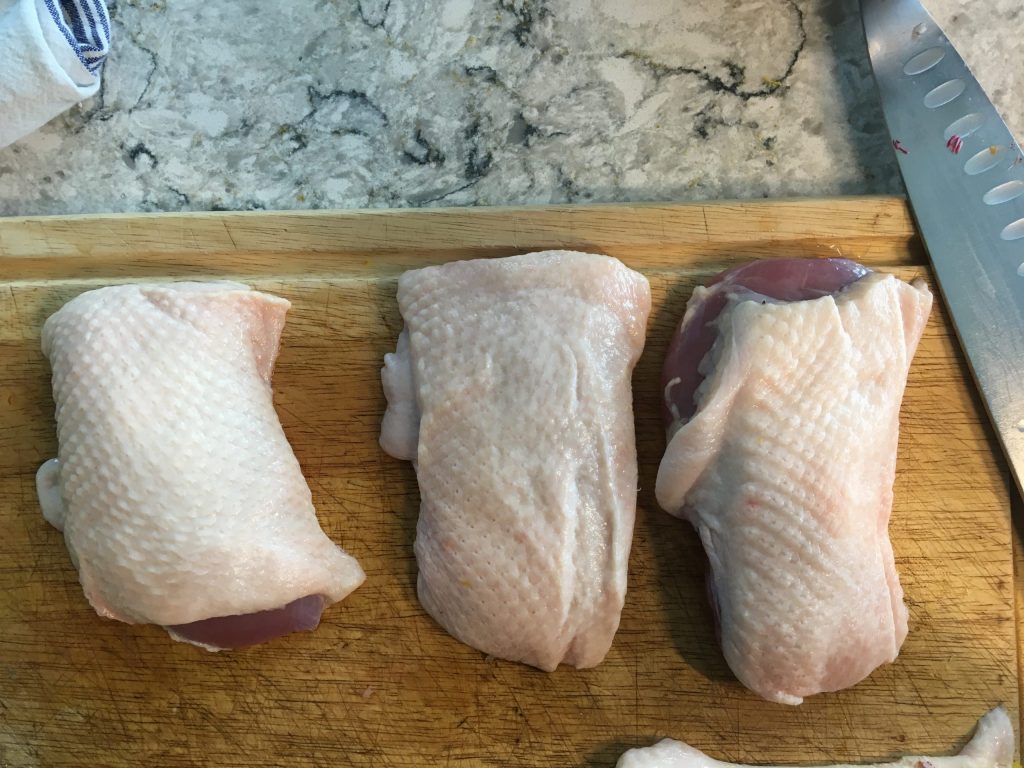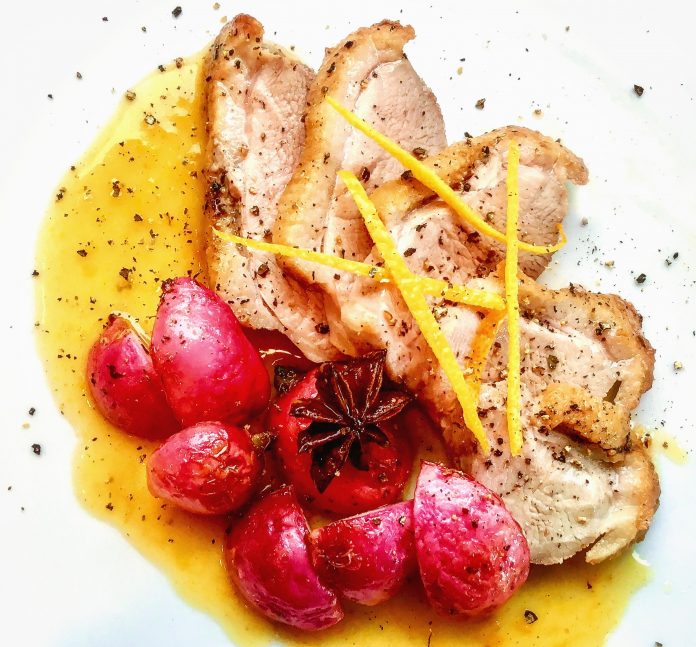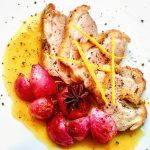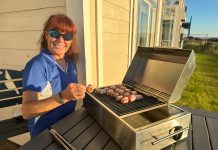I’ll put it right out there…this is NOT your stereotypical Duck a l’Orange with it’s cloying sweet orange Marmalade-tasting sauce. THIS is a duck everyone can, and should, have in their recipe files.
Why? Well, first of all, because it’s tasty. Isn’t that enough?
There are other great reasons, such as…it’s duck. Now, I know a lot of you don’t get into duck, and part of the reason is, can I say it — fear. “I don’t know how to cook duck.” “It looks complicated.” “It takes too long.” I’ve heard all of those excuses and I’m hear to tell you, you’re wrong. It doesn’t HAVE to be any of those things.
Here, let me prove it. Last week I was the happy recipient of a shipment of duck from Maple Leaf Farms. I had both breasts and legs to work with, but I opted for the breasts for this one. Primarily because…honestly…I couldn’t WAIT to work with it and, being a weeknight, I had a busy day and didn’t want to tackle the legs yet (oh, but I will…wait ’til you see what I have planned for those babies!
So, duck breast it is. They came four breasts to a package so it was just perfect. Dinner for two and extra.
The first thing I noticed is how well-proportioned the breasts were. And, just the right amount of fat under the skin. The fat is important, even though we try to cook a lot of it out before serving. In this case, the duck fat is also part of what makes the sauce work…no fear, ok? I’ll show you how to work this.

As always, it’s a great idea to get all your ingredients together before starting to cook, and this recipe is no different. Once you have your duck ready, you’re going to cut slits in the skin at a roughly 45 degree angle. You want to use a really sharp knife so your cuts are neat, not jagged, and you want to take care to cut only through skin and fat, NOT the meat. Be gentle, but firm.
I rubbed a mixture of salt and pepper on the duck breasts making sure I got some into the cuts as well as on the underside of the duck. Then, I heated a heavy-bottomed skillet on high. You want the pan to be really hot so that you’ll get a nice sear on the skin. It’s also part of how we will render the fat. If you have a range-hood fan, I suggest you turn it on because your duck will smoke. It’s going to take about 5-8 minutes for your skin to get caramelized and crispy, so don’t think you’re cooking it too long. Once you have reached that point, carefully flip your duck over and cook the meat side. You can turn your pan down a bit at this point, but you will want fairly high heat. Cook it another 5-8 minutes and then remove the duck to a sheet pan and place it in your preheated oven.
See…nothing scary so far, right? You can do this. The hard part is over.
Now…let’s make some sauce.
You want to use the duck fat that remains in the pan, that’s part of where the richness of flavor comes in. The sauce is going to be a combination of onions, aromatics, fresh orange juice and chicken broth, to which you’ll add arrowroot as a thickener.
Take a note: the USDA recommends cooking duck to an internal temp of 160-170. BUT, you also have to factor in the time you rest the duck breast after taking it out of the oven. What happens if you don’t rest it…well, you’ll end up with lots of the lovely juices spilled all over your cutting board and not absorbed into the meat. Dry duck. Also, overcooking the duck will result in dry meat so I pull my duck at 140 degrees, tent it with foil and let it rest while I do the final-final on the sauce.
To serve the duck, you can certainly place it whole on the plate and spoon the sauce over it, but it will soften your crispy skin a bit that way. I like to slice it on an angle and then place it fanned out on a little pool of the sauce, perhaps drizzling a little more over it. Garnish can be some more of the orange zest you made during the prep, maybe some little shreds instead of grated, and fresh ground black pepper. Because I wanted to keep it keto, I served it with sauteed radishes as a side.
So, bottom line: start with good ingredients, add some great complimentary fresh flavors and in roughly 30 minutes you’ll have a restaurant worthy meal that you made at home. Give it a try and let me know how it worked for you — even share a pic! And, keep following to see what I do with some duck legs next time.
Seared Duck Breast with Orange Sauce
Ingredients
- 2 duck breasts, skin on
- Kosher salt & pepper
- 2 Tbsp olive oil
- 1/2 medium onion, sliced thinly
- 1/2 small orange, juice squeezed and zest reserved
- 4 pcs star anise
- 1 tsp arrowroot flour
- 1/2 cup chicken broth
- 1 tsp unfiltered apple cider vinegar or more, to taste
- additional orange zest for garnish, if desired
Instructions
- Take the star anise and the zest from the 1/2 orange and tie into a small cheesecloth bundle. Set aside
- Preheat the oven to 350°F
- With a very sharp knife, score the skin of the duck breast at a 45 degree angle, taking care to cut only the skin and not through to the meat. Rub both breasts with salt and pepper on both sides, taking care to get salt/pepper mix into the slits cut into the skin.
- Heat a skillet over high heat. When the skillet is VERY hot, place duck breasts, skin side down into the pan.
- Sear the duck breast until the skin caramelizes and turns quite crispy, about 5-8 minutes. Using tongs or a very thin flexible spatula, flip duck breasts to meat-side down and cook for a few more minutes until browned, approximately 5 minutes. Remove the breasts meat-side down to a greased or oiled sheet tray and place in the oven to finish cooking (approx 10-15 minutes more). While the USDA recommends you cook duck breast to an internal temperature of 160-170°F, remember that the duck will continue to cook a bit once you remove it from the oven, while you are letting it rest. If you enjoy duck medium-rare, you'll want to remove it at 140° and let it rest for at least 5 minutes before slicing/finishing your dish.
- While the duck is cooking, make the sauce. Leave the rendered duck fat in the pan, add olive oil and onions. Cook over medium heat until onions are caramelized and golden.
- Add the orange juice to deglaze the pan, and add the cheesecloth packet of spice/zest. Cook this mixture for a minute or two.
- Remove the sauce from the heat and strain through a fine-meshed strainer, pressing on the onion solids. Discard the onion but reserve the sauce packet.
- Meanwhile, whisk the arrowroot flour with the 1/2 cup chicken broth.
- Return the strained sauce to the pan. Open the spice packet and add the contents to the sauce in the pan. Add the apple cider vinegar to taste.
- Whisk chicken broth and arrowroot mixture together and add to pan. Cook the sauce over low heat for 1-2 minutes until mixture has thickened slightly. Adjust seasonings necessary.
- Slice duck on the bias and serve with sauce. Garnish with additional orange zest and grinds of fresh black pepper as desired.






